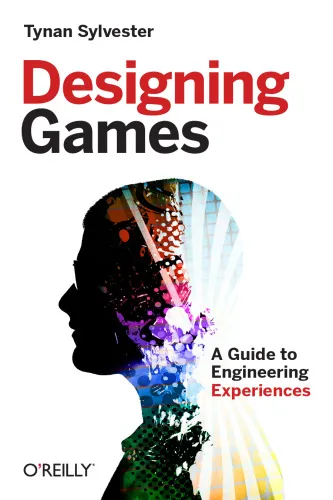Designing Games: A Guide to Engineering Experiences
4.8
Reviews from our users

You Can Ask your questions from this book's AI after Login
Each download or ask from book AI costs 2 points. To earn more free points, please visit the Points Guide Page and complete some valuable actions.Analytical Summary
"Designing Games: A Guide to Engineering Experiences" is a thoughtful and detailed roadmap for designers, developers, and scholars who seek to create immersive, meaningful game experiences. Written by an industry veteran, the text blends academic insight with practical methodology to guide readers through the complexities of interactive system creation, from conceptual frameworks to real-world implementation.
Rather than focusing solely on rules or mechanics, the book delves into the human side of game development — how players perceive, react, and emotionally invest in what unfolds on screen. This work situates itself firmly at the intersection of art, science, and engineering, making it valuable to a wide audience from aspiring designers to seasoned professionals.
Structured around principles of experience engineering, the content covers pacing, feedback systems, emergent gameplay, motivation models, and the narrative resonance that binds all these together. While the publication year is Information unavailable due to no reliable public source, the text remains timeless in its applicability, stressing the enduring importance of designing for human engagement rather than transient technological trends.
The author’s voice is clear and authoritative, carrying lessons distilled from substantial practical experience. Each chapter is built to spark both analytical thought and creative experimentation, reinforcing the concept that strong game design emerges from iterative refinement, well-chosen constraints, and deep empathy toward the player journey.
Key Takeaways
The book imparts enduring lessons relevant to anyone aiming to craft games that resonate on an emotional and cognitive level. These takeaways extend beyond surface aesthetics to the systems and psychology underpinning successful gameplay.
First, fruitful game design begins with the recognition that players are active co-creators of their own experience. Understanding motivation — whether it is curiosity, competition, or mastery — is key to engineering engagement.
Second, pacing is not a mere function of difficulty scaling; it’s the orchestration of tension and release that seasons a player’s emotional arc. This principle helps maintain long-term interest.
Third, meaningful feedback loops — both in mechanics and narrative — deepen immersion. When players understand the consequences of their actions, they invest more profoundly.
Fourth, constraints can power creativity. Limitations in mechanics, resources, or narrative pathway often compel innovative solutions.
Finally, engineering experiences entails respect for complexity while ensuring accessibility. Balance is paramount: too simple undermines engagement; too complex alienates the player.
Memorable Quotes
"Great game design is not about adding features; it’s about shaping the player's journey." Unknown
"Mechanics are the bones of a game, but emotions are the heartbeat." Unknown
"In designing experiences, every choice echoes through the player's story." Unknown
Why This Book Matters
"Designing Games: A Guide to Engineering Experiences" matters because it bridges theory with applied design. It is rare to find a resource that speaks to both the rational analysis needed for engineering systems and the artistic intuition that crafts emotional resonance.
In the current landscape, where gaming is both a dominant entertainment medium and a growing educational and professional tool, understanding the core principles outlined here is invaluable. The book's insistence on designing experiences — not just mechanics — helps foster games that endure cultural shifts and technological evolution.
For academics, it offers a structured framework for research and teaching. For professionals, it provides a lens to evaluate and improve their practice. For serious enthusiasts, it offers a deeper appreciation for the invisible architecture that makes games memorable.
Inspiring Conclusion
Ultimately, "Designing Games: A Guide to Engineering Experiences" is more than a manual — it is a call to thoughtful creation. Whether you stand at the threshold of your first project or have years behind you in the industry, the ideas within challenge you to think deeply about every choice.
By embracing both analytical precision and artistic empathy, you can craft interactive works that not only function but truly resonate. This book invites you to dissect and reassemble the very mechanics of enjoyment, translating abstract theory into palpable experiences for diverse audiences.
If you are ready to elevate your approach, let "Designing Games: A Guide to Engineering Experiences" be your companion in exploration and execution. Read it, share its insights, discuss its ideas — and most importantly, apply them to engineer experiences that matter.
Free Direct Download
You Can Download this book after Login
Accessing books through legal platforms and public libraries not only supports the rights of authors and publishers but also contributes to the sustainability of reading culture. Before downloading, please take a moment to consider these options.
Find this book on other platforms:
WorldCat helps you find books in libraries worldwide.
See ratings, reviews, and discussions on Goodreads.
Find and buy rare or used books on AbeBooks.
1006
بازدید4.8
امتیاز50
نظر98%
رضایتReviews:
4.8
Based on 0 users review
"کیفیت چاپ عالی بود، خیلی راضیام"
Questions & Answers
Ask questions about this book or help others by answering
No questions yet. Be the first to ask!


